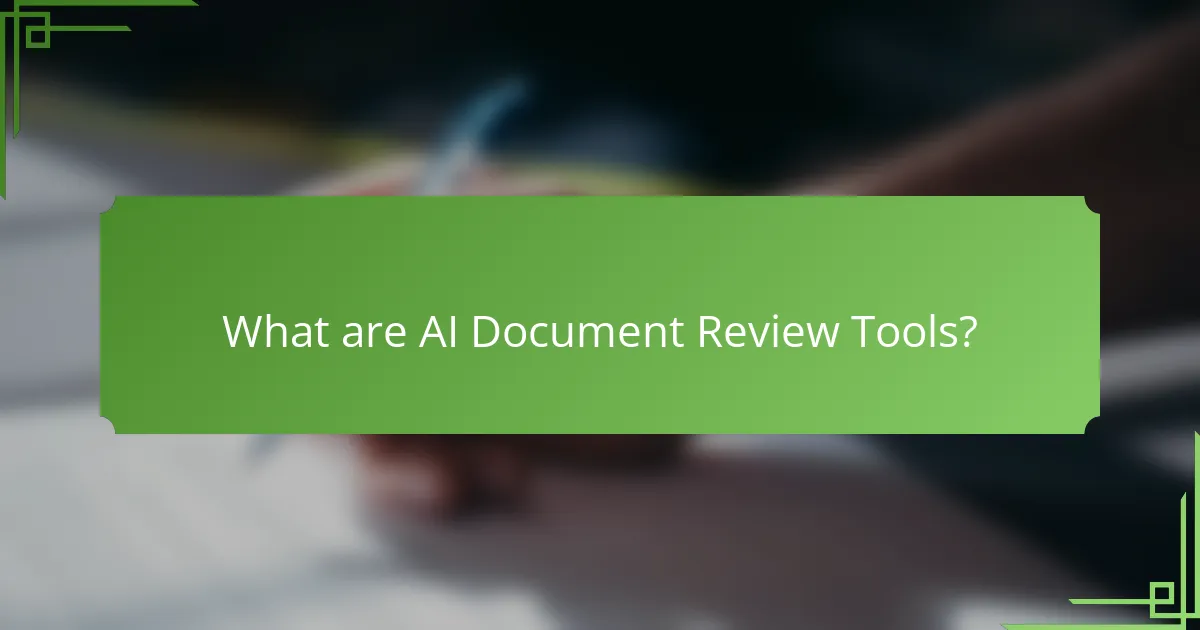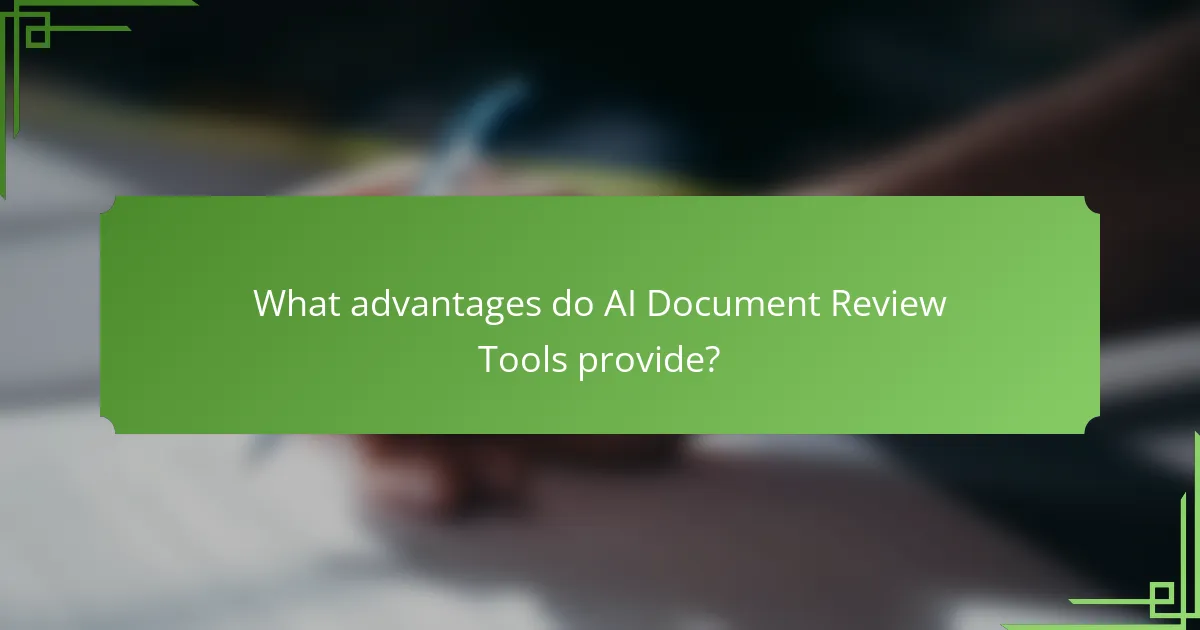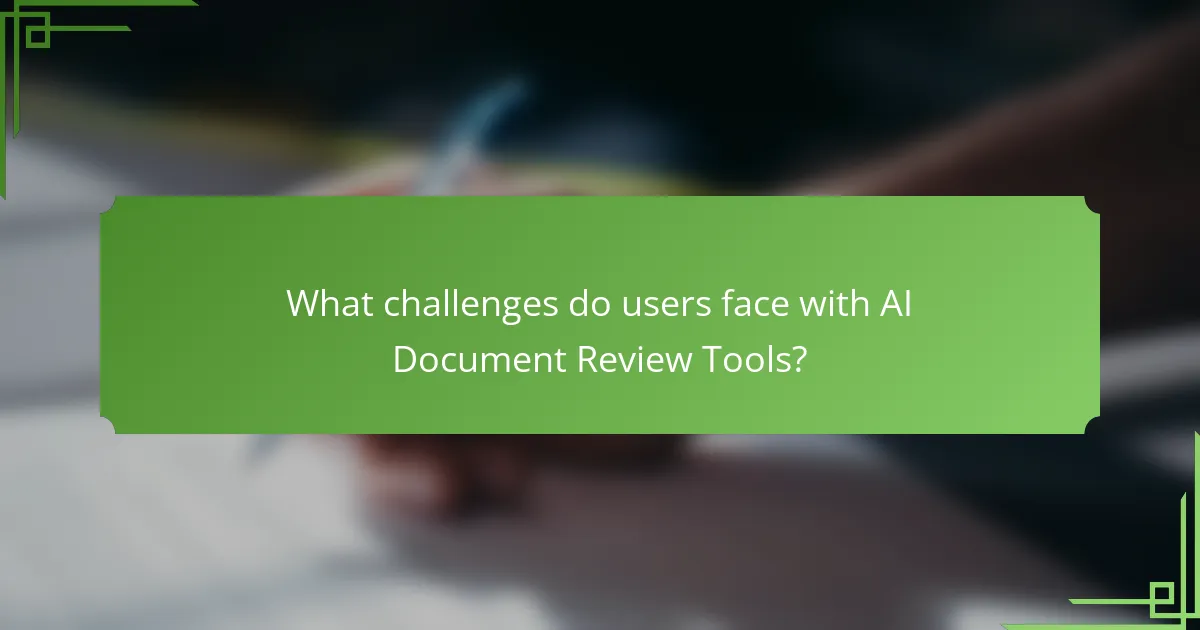
What are AI Document Review Tools?
AI Document Review Tools are software applications that utilize artificial intelligence to analyze and review legal documents. These tools enhance the efficiency of legal research by automating tasks such as contract analysis, document comparison, and compliance checking. AI algorithms can identify relevant information quickly, reducing the time lawyers spend on manual reviews. According to a study by McKinsey, legal professionals can save up to 23% of their time using AI tools. This increased efficiency allows for more focus on complex legal analysis and strategy.
How do AI Document Review Tools function in legal research?
AI Document Review Tools function by automating the analysis of legal documents. They utilize natural language processing to understand and categorize text. These tools identify relevant information quickly, reducing the time lawyers spend on document review. They can flag important clauses or inconsistencies in contracts. Additionally, they assist in e-discovery by sifting through large volumes of data. Many tools employ machine learning to improve their accuracy over time. Studies show that AI tools can increase review speed by up to 80%. This efficiency allows legal professionals to focus on strategic tasks rather than manual document analysis.
What technologies power AI Document Review Tools?
AI Document Review Tools are powered by several key technologies. Natural Language Processing (NLP) enables these tools to understand and interpret human language. Machine Learning algorithms allow the systems to learn from data patterns and improve over time. Optical Character Recognition (OCR) technology converts scanned documents into editable and searchable formats. Cloud computing provides the necessary infrastructure for storage and processing of large datasets. Additionally, data analytics tools help in extracting insights from documents efficiently. These technologies collectively enhance the accuracy and speed of document review processes in legal research.
How do these technologies improve document analysis?
AI document review tools enhance document analysis by automating data extraction and identifying relevant information quickly. These technologies utilize machine learning algorithms to analyze large volumes of documents efficiently. They can recognize patterns and categorize information based on context. This reduces human error and increases accuracy in identifying critical data points. For instance, studies show that AI tools can process documents up to 80% faster than traditional methods. Additionally, they provide advanced search capabilities, allowing users to find specific terms or phrases within documents instantly. This leads to significant time savings in legal research and review processes.
What are the key features of AI Document Review Tools?
AI Document Review Tools feature automation, advanced search capabilities, and machine learning integration. Automation streamlines the review process by reducing manual labor. Advanced search capabilities allow users to quickly find relevant documents using keywords or phrases. Machine learning integration improves accuracy over time by learning from user interactions and feedback. These tools also offer collaboration features, enabling multiple users to work on documents simultaneously. Additionally, they provide analytics to track review progress and identify bottlenecks. Security measures ensure that sensitive information is protected during the review process. Overall, these features enhance efficiency and accuracy in legal research.
Which features enhance accuracy in legal research?
Advanced search algorithms enhance accuracy in legal research. These algorithms utilize natural language processing to understand context. They improve search relevance by interpreting legal terminology effectively. Comprehensive databases provide access to a wide range of legal resources. This access allows researchers to cross-reference case law and statutes easily. Document analytics tools identify key legal concepts and precedents. These tools help in pinpointing relevant information quickly. User-friendly interfaces facilitate efficient navigation through complex legal documents. Accurate citation tools ensure proper referencing of legal materials.
How do speed and efficiency improve with these tools?
AI document review tools significantly enhance speed and efficiency in legal research. These tools automate the process of reviewing large volumes of documents. This automation reduces the time lawyers spend on manual document analysis. For instance, AI can quickly identify relevant case law and statutes, streamlining the research process. Additionally, these tools utilize machine learning algorithms to improve accuracy over time. They can flag pertinent information faster than traditional methods. Studies show that law firms using AI tools can reduce document review time by up to 70%. This allows legal professionals to focus on strategic tasks rather than routine document handling.

What advantages do AI Document Review Tools provide?
AI Document Review Tools enhance efficiency in legal research. They automate the review process, saving time compared to manual reviews. These tools can analyze large volumes of documents quickly. They improve accuracy by reducing human error in document analysis. AI algorithms can identify relevant information more effectively. Many tools utilize machine learning to adapt and improve over time. Studies show that AI tools can reduce document review costs by up to 70%. Their ability to flag inconsistencies helps legal teams maintain compliance.
How do these tools impact the legal profession?
AI document review tools significantly enhance the legal profession by increasing accuracy and efficiency. These tools automate the review process, reducing human error. They can quickly analyze vast amounts of legal documents. This saves time compared to traditional manual reviews. According to a study by McKinsey, legal professionals can reduce document review time by up to 80% using AI tools. Additionally, AI tools can identify relevant case law and precedents faster than human researchers. This allows lawyers to focus more on strategic aspects of their cases. Overall, the integration of AI tools leads to improved client service and reduced operational costs in law firms.
What cost savings can be achieved with AI Document Review Tools?
AI Document Review Tools can achieve significant cost savings by reducing the time and labor required for document analysis. These tools automate the review process, allowing for faster identification of relevant information. Traditional document review can take thousands of hours, while AI tools can complete similar tasks in a fraction of the time. This efficiency translates to lower labor costs and reduced billable hours for legal professionals.
Moreover, AI tools can minimize errors, decreasing the need for costly revisions or additional reviews. Studies show that firms using AI for document review can save up to 30% on overall review costs. By streamlining workflows and enhancing productivity, AI Document Review Tools provide a compelling financial advantage for legal research.
How do they reduce human error in legal documentation?
AI document review tools reduce human error in legal documentation by automating the analysis process. They utilize machine learning algorithms to identify inconsistencies and errors. These tools can compare documents against legal standards and past cases. By doing so, they ensure compliance and accuracy. Additionally, they provide real-time feedback to users during document creation. This immediate correction capability minimizes the chance of oversight. Studies show that AI tools can increase accuracy rates by over 90%. Their ability to learn from previous documents enhances their effectiveness over time.
Why are AI Document Review Tools essential for modern law firms?
AI Document Review Tools are essential for modern law firms because they significantly enhance efficiency and accuracy in legal research. These tools automate the review process, allowing attorneys to analyze large volumes of documents quickly. According to a study by McKinsey, legal professionals can save up to 30% of their time through automation. AI tools can identify relevant information and flag critical issues, reducing the risk of human error. Additionally, they streamline workflows, enabling lawyers to focus on more strategic tasks. This technology also supports compliance and risk management by ensuring thorough document analysis. The integration of AI in legal practices is becoming a standard for maintaining competitive advantage.
What role does automation play in legal research?
Automation significantly enhances the efficiency of legal research. It streamlines the process by quickly sorting through vast amounts of legal data. Automated tools can analyze case law, statutes, and regulations faster than traditional methods. This technology reduces the time spent on manual research tasks. According to a study by the American Bar Association, automation can decrease legal research time by up to 50%. Additionally, automation minimizes human error in data analysis. It allows legal professionals to focus on strategic decision-making rather than repetitive tasks. Overall, automation plays a crucial role in modernizing and improving the legal research landscape.
How do these tools support compliance and risk management?
AI document review tools support compliance and risk management by automating the analysis of legal documents. These tools enhance accuracy by identifying relevant regulations and compliance requirements. They reduce the risk of human error in document review processes. AI algorithms can quickly scan large volumes of documents for compliance-related keywords and phrases. This capability allows legal teams to ensure adherence to laws and regulations efficiently. Additionally, these tools provide audit trails that document compliance efforts. This documentation is crucial during regulatory audits. Overall, AI document review tools streamline compliance processes and mitigate risks effectively.

What challenges do users face with AI Document Review Tools?
Users face several challenges with AI Document Review Tools. One significant challenge is the accuracy of results. AI tools may misinterpret legal terminology or context, leading to incorrect conclusions. Another challenge is the integration with existing systems. Users often find it difficult to incorporate these tools into their current workflows. Furthermore, there is a lack of transparency in AI decision-making. Users may not understand how the tool reached a specific outcome. Data privacy concerns also arise, as sensitive legal documents are processed by AI systems. Finally, users may encounter high costs associated with implementing and maintaining these tools.
What are common misconceptions about AI Document Review Tools?
Common misconceptions about AI Document Review Tools include the belief that they can fully replace human reviewers. While AI can automate repetitive tasks, human judgment remains essential for nuanced understanding. Another misconception is that AI tools are infallible. In reality, they can make errors, especially with complex documents. Some users think these tools are only beneficial for large firms. However, smaller firms can also leverage AI for efficiency. Lastly, many believe that AI tools require extensive technical knowledge to operate. Most modern AI document review tools are designed to be user-friendly, requiring minimal training.
How can users overcome resistance to adopting these tools?
Users can overcome resistance to adopting AI document review tools by understanding their benefits. Education about the efficiency and accuracy these tools provide is essential. Training sessions can help users feel more comfortable with the technology. Demonstrating successful case studies can build trust in the tools’ effectiveness. Providing ongoing support ensures users can address challenges as they arise. Encouraging feedback allows users to share experiences and improve the adoption process. Statistics show that firms using AI tools report significant time savings and reduced errors. For instance, a study by McKinsey found that AI can reduce document review time by up to 80%.
What limitations should users be aware of?
AI document review tools have limitations that users must recognize. These tools may struggle with complex legal language and nuanced context. They can misinterpret ambiguous phrases, leading to errors in document analysis. Additionally, AI tools often require substantial training data to function effectively. Limited training data can result in incomplete or biased outcomes. Users should also be aware of potential issues with data privacy and security. Sensitive information may be exposed if proper safeguards are not implemented. Finally, these tools may not fully replace human judgment in legal research. Human oversight remains essential for ensuring accuracy and compliance.
How can users maximize the effectiveness of AI Document Review Tools?
Users can maximize the effectiveness of AI Document Review Tools by providing high-quality input data. Accurate and well-structured documents improve the AI’s ability to analyze and extract relevant information. Regularly updating the AI with new legal precedents enhances its learning and accuracy. Setting clear parameters for the review process helps the AI focus on specific details. Training sessions for users on how to interact with the tool can lead to better results. Utilizing the tool’s features, such as keyword searches and filters, can streamline the review process. Monitoring the AI’s output for consistency ensures that it meets the user’s standards. Engaging with support resources can provide insights into advanced functionalities.
What best practices should be followed when using these tools?
Utilize AI document review tools effectively by following best practices. Start with clear objectives to guide the review process. Ensure data quality by inputting accurate and relevant documents. Regularly train the AI tool to improve its learning and accuracy. Monitor the tool’s performance to identify any discrepancies. Collaborate with legal experts to validate AI-generated insights. Maintain confidentiality and data security throughout the review process. Document findings and decisions for future reference and accountability. These practices enhance the overall efficiency and reliability of legal research using AI tools.
How can training improve user experience with AI Document Review Tools?
Training can significantly improve user experience with AI Document Review Tools by enhancing user proficiency. Well-structured training programs educate users on tool functionalities. This knowledge allows users to navigate the software more effectively. Improved navigation leads to quicker document processing times. Training also helps users understand AI algorithms, fostering trust in the technology. Users become more adept at identifying relevant documents and insights. Research indicates that trained users experience a 30% increase in efficiency. Thus, targeted training directly correlates with improved user satisfaction and productivity.
AI Document Review Tools are software applications that leverage artificial intelligence to streamline the analysis and review of legal documents, enhancing efficiency in legal research. These tools automate tasks such as contract analysis and compliance checking, significantly reducing the time lawyers spend on manual reviews. Key technologies include Natural Language Processing, Machine Learning, and Optical Character Recognition, which collectively improve accuracy and speed in document analysis. The article will explore the functionalities, advantages, challenges, and best practices associated with these tools, highlighting their impact on the legal profession and the potential for cost savings.